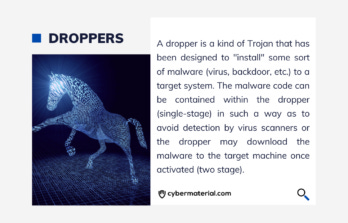
A dropper is a kind of Trojan that has been designed to “install” some sort of malware (virus, backdoor, etc.) to a target system. The malware code can be contained within the dropper (single stage) in such a way as to avoid detection by virus scanners or the dropper may download the malware to the target machine once activated (two stage).
A dropper, in the context of malware, refers to a specific component or functionality within a malware program. Its primary purpose is to deliver and install additional malware or malicious payloads onto a targeted system.
The term “dropper” comes from the analogy of a dropper bottle that dispenses liquid in precise amounts. In the context of malware, a dropper serves as a delivery mechanism that carries the actual malware payload and executes it on the victim’s system. The dropper itself may appear benign or disguised as a legitimate file or program to evade detection and deceive the user.
The dropper typically performs several actions to achieve its objective:
Execution: The dropper is designed to run automatically, either by being executed directly or by exploiting vulnerabilities in the targeted system or software.
Payload retrieval: The dropper may connect to a remote server or retrieve the malware payload from an embedded source. It can do so through various communication protocols like HTTP, FTP, or even peer-to-peer networks.
Payload installation: Once the dropper has obtained the malicious payload, it proceeds to install or execute it on the infected system. This could involve writing the malware to disk, modifying system settings, or injecting code into legitimate processes.
Obfuscation: Droppers often employ techniques to obfuscate or hide their malicious nature. This may involve encrypting or packing the payload, using anti-analysis mechanisms, or employing polymorphic or metamorphic techniques to change their appearance.
Droppers are commonly used in various types of malware attacks, including ransomware, banking trojans, spyware, and other advanced persistent threats (APTs). They allow attackers to deliver and install malware discreetly, evade detection by security solutions, and carry out further malicious activities on the compromised system.
To protect against dropper-based attacks, it is essential to maintain up-to-date antivirus software, apply security patches promptly, exercise caution when downloading or executing files from untrusted sources, and implement a multi-layered security approach that includes network monitoring, intrusion detection systems, and user education to detect and prevent the installation of malicious droppers.
The post What are Droppers? (Malware) first appeared on CyberMaterial.


